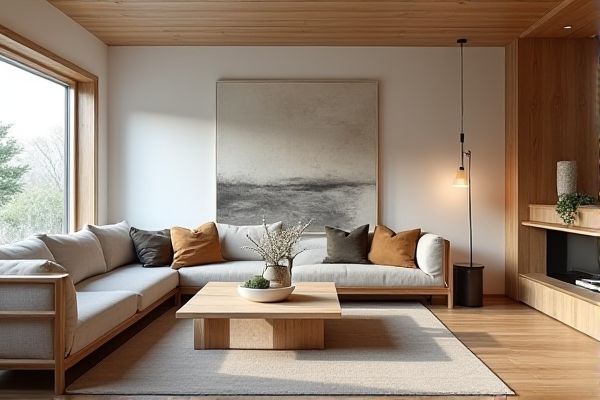
Scandinavian style emphasizes minimalism, functionality, and light, airy spaces with a focus on natural materials and neutral colors. Japandi style blends Scandinavian simplicity with Japanese rustic elegance, creating warm, cozy interiors with a balance of functionality and serene aesthetics--explore the rest of the article to discover which style suits Your home best.
Table of Comparison
| Aspect | Scandinavian Style | Japandi Style |
|---|---|---|
| Origin | Scandinavia (Denmark, Sweden, Norway) | Fusion of Japanese and Scandinavian design |
| Design Philosophy | Minimalism, functionality, and simplicity | Wabi-sabi meets minimalism; harmony and balance |
| Color Palette | Light neutrals, whites, soft pastels | Neutral tones, muted colors, natural earth hues |
| Materials | Natural wood, wool, leather, cotton | Wood, bamboo, paper, natural fabrics |
| Furniture | Simple, functional, often light wood | Low-profile, streamlined, handcrafted elements |
| Decor Elements | Minimal accessories, focus on light and space | Natural textures, plants, handcrafted pottery |
| Lighting | Bright, natural light emphasized | Soft, ambient lighting to create calm |
| Overall Mood | Fresh, airy, practical | Calm, cozy, balanced |
Introduction to Scandinavian and Japandi Styles
Scandinavian style emphasizes minimalism, functionality, and natural light, featuring clean lines, neutral colors, and cozy textures that create a warm and inviting atmosphere. Japandi style blends Scandinavian simplicity with Japanese elegance, highlighting natural materials, muted tones, and a balance between minimalism and warmth. Your interior can achieve serene sophistication by combining the best elements of both styles, enhancing comfort and aesthetic appeal.
Defining the Core Principles
Scandinavian style emphasizes simplicity, functionality, and natural light, characterized by clean lines, muted colors, and cozy textures to create a warm, inviting atmosphere. Japandi style merges Scandinavian minimalism with Japanese wabi-sabi aesthetics, focusing on natural materials, craftsmanship, and balanced, calming spaces that celebrate imperfection. Understanding these core principles helps you choose a design that harmonizes comfort with refined elegance for your living space.
Historical Origins and Influences
Scandinavian style originates from the early 20th century Nordic countries, emphasizing simplicity, functionality, and natural materials inspired by the region's cold climate and minimalist art movements. Japandi style merges Scandinavian minimalism with traditional Japanese aesthetics, drawing from Japan's wabi-sabi philosophy and handcrafted furniture techniques, creating a harmonious blend of warmth and serenity. Both styles prioritize clean lines and natural elements but differ in cultural origins and historical influences, combining Western and Eastern design principles in Japandi.
Key Color Palettes
Scandinavian style features a bright, neutral color palette dominated by whites, soft grays, and pale blues, creating an airy and minimalist aesthetic. Japandi style combines these muted tones with warm, natural hues such as deep browns, charcoal, and soft greens inspired by Japanese wabi-sabi principles. Your choice between these styles should consider whether you prefer the cool, crisp lightness of Scandinavian colors or the balanced warmth and earthiness found in Japandi palettes.
Furniture and Materials
Scandinavian style features light wood furniture with clean lines and functional design, emphasizing natural materials such as pine, beech, and wool for a cozy yet minimalist aesthetic. Japandi style combines Scandinavian simplicity with Japanese rustic elegance, integrating darker woods like oak or walnut alongside natural fibers like bamboo and linen to create a balanced, serene atmosphere. Both styles prioritize craftsmanship and sustainability but differ in their color palettes and textural contrasts, with Japandi leaning toward muted, earthy tones versus the brighter hues of Scandinavian interiors.
Approach to Minimalism
Scandinavian style emphasizes functional minimalism with a focus on simplicity, natural light, and cozy elements like soft textiles and warm wood tones. Japandi style merges Scandinavian minimalism with Japanese Zen principles, prioritizing calm, uncluttered spaces that highlight craftsmanship and natural materials with a serene, balanced aesthetic. Your choice between these styles depends on whether you prefer the inviting warmth of Scandinavian design or the meditative tranquility of Japandi minimalism.
Use of Nature and Natural Light
Scandinavian style emphasizes the use of natural light through large windows and light-colored interiors to create an airy, bright atmosphere, incorporating natural materials like wood and wool for warmth. Japandi style combines this with Japanese minimalism, using natural light sparingly to highlight craftsmanship and textures from materials such as bamboo, rattan, and stone. Both styles prioritize nature by integrating organic elements indoors, but Japandi tends to evoke a more serene, balanced ambiance through intentional light and nature interaction.
Decorative Elements and Accessories
Scandinavian style emphasizes minimalistic decorative elements such as simple ceramics, woven textiles, and natural wood accents that create a cozy, functional atmosphere. Japandi style blends this simplicity with Japanese-inspired accessories like tatami mats, shoji screens, and ceramics featuring subtle textures and muted colors, enhancing a sense of calm and balance. Your choice between these styles can influence how accessories complement both form and function, blending warmth with understated elegance.
Functionality and Comfort
Scandinavian style emphasizes minimalism and functionality with clean lines, natural materials, and cozy textiles that create an inviting atmosphere. Japandi style blends Scandinavian practicality with Japanese elegance, focusing on simplicity, craftsmanship, and balanced comfort that promotes tranquility. Your living space can benefit from combining these aesthetics to achieve both efficient design and warm, serene comfort.
Which Style Suits Your Home?
Scandinavian style emphasizes light, airy spaces with minimalistic furniture, natural materials, and a neutral color palette, ideal for homes seeking simplicity and functionality. Japandi style blends Scandinavian minimalism with Japanese wabi-sabi aesthetics, featuring clean lines, muted tones, and a focus on craftsmanship and natural textures, perfect for those who appreciate subtle elegance and tranquility. Your choice depends on whether you prefer the bright, cozy vibe of Scandinavian design or the serene, refined atmosphere of Japandi interiors.
 homyna.com
homyna.com